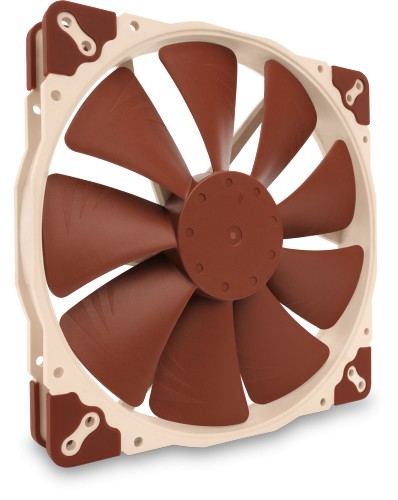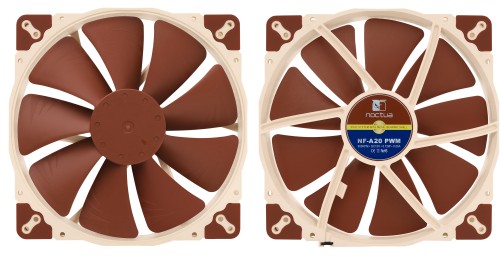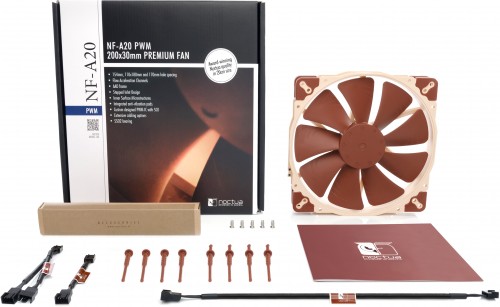NF-A20 PWM 12V 800RPM 200x30mm Extra Large Quiet Fan € 30.82 5 in stock | ||
| More variations available Show | ||
Noctua NF-A20 PWM 12V 800RPM 200x30mm Extra Large Quiet Fan
Noctua have crammed all of their expertise in to this exceptionally quiet new 200mm PWM fan.
Features
- Award-winning Noctua quality in a 200mm fan
- Noctua’s AAO (Advanced Acoustic Optimisation)
- 154mm, 110x180mm and 170mm hole spacing
- Integrated Anti-Vibration Pads
- Six year warranty
- From 59.3 CFM, 10.7 dBA at 550 RPM
The NF-A20 is a highly optimised, premium quality quiet 200mm fan. Featuring an AAO (Advanced Acoustic Optimisation) standard frame as well as sophisticated aerodynamic design measures such as Flow Acceleration Channels, the NF-A20 brings the renowned quiet cooling performance of Noctua’s award-winning A-series to the increasingly popular 200mm form factor. The PWM version uses Noctua’s custom designed NE-FD1 IC for fully automatic speed control via 4-pin fan headers, which allows it to strike a perfect balance between quietness and ventilation performance in each given situation. Its superb running smoothness, reference-class SSO2 bearing and Noctua’s trusted premium quality make the NF-A20 an elite choice for the highest demands.
Award-winning Noctua quality in 200mm size
While more and more PC cases support 200mm intake, side-panel or exhaust fans, many of the bundled stock units and available aftermarket options are of questionable quality. By contrast, the NF-A20 is a true premium grade solution worthy of Noctua’s award-winning A-series.
154mm, 110x180mm and 170mm hole spacing
In order to ensure broad compatibility with today’s PC cases, the NF-A20 features three sets of mounting holes: While the 154x154mm and 110x180mm spacing allow it to replace most 200mm fans, the 170x170mm spacing is used by many 230 and 250mm fans, which can thus also be replaced by the NF-A20.*
Flow Acceleration Channels
The NF-A20 impeller features suction side Flow Acceleration Channels. By speeding up the airflow at the crucial outer blade regions, this measure reduces suction side flow separation and thus leads to better efficiency and lower vortex noise.
AAO Frame
Noctua’s AAO (Advanced Acoustic Optimisation) frames feature integrated anti-vibration pads as well as Noctua’s proprietary Stepped Inlet Design and Inner Surface Microstructures, both of which further refine the fan’s performance/noise efficiency.
Stepped Inlet Design
Noctua’s Stepped Inlet Design adds turbulence to the influx in order to facilitate the transition from laminar flow to turbulent flow, which reduces tonal intake noise, improves flow attachment and increases suction capacity, especially in space-restricted environments.
Inner Surface Microstructures
With the tips of the fan blades ploughing through the boundary layer created by the Inner Surface Microstructures, flow separation from the suction side of the blades is significantly suppressed, which results in reduced blade passing noise and improved airflow and pressure efficiency.
Integrated anti-vibration pads
Integrated anti-vibration pads made from extra-soft silicone minimise the transmission of minute vibrations while maintaining full compatibility with all standard screws and other mounting systems.
Custom-designed PWM IC with SCD
Supporting fully automatic PWM speed control, the fan uses Noctua’s custom-designed NE-FD1 PWM IC that integrates Smooth Commutation Drive (SCD) technology. By providing smoother torque impulses, SCD suppresses PWM switching noises and thus makes the fan quieter at low speeds.
Low-Noise Adaptor
The NF-A20 PWM is supplied with a L.N.A. that reduces the maximum fan speed from 800 to 550rpm. The L.N.A. can be used either to run the fan at a fixed speed of 550rpm or to cap the maximum speed when using automatic PWM control.
Extensive cabling options
The fan’s short 200mm primary cable minimises cable clutter in typical applications while the supplied 30cm extension provides extended reach when necessary. Both cables are fully sleeved and a 4-pin y-cable allows the connection of a second fan to the same PWM fan header for automatic control.
SSO2 bearing
The NF-A20 features the further optimised second generation of Noctua’s renowned, time-tested SSO bearing. With SSO2, the rear magnet is placed closer to the axis to provide even better stabilisation, precision and durability.
6-year manufacturer’s warranty
Noctua fans are renowned for their impeccable quality and outstanding longevity. Like all Noctua fans, the NF-A20 features an MTTF of more than 150,000 hours rating and comes with a full 6-year manufacturer’s warranty.
| Specifications | NF-A20 PWM 200mm |
|---|---|
| Dimensions | 200 x 200 x 30 mm |
| Mounting hole spacing | 154x154, 110x180, 170x170 mm * |
| Connector | 4-Pin PWM |
| Bearing | SSO2 |
| Blade Geometry | A-Series with Flow Acceleration Channels |
| Frame Technology | AAO (Advanced Acoustic Optimisation) |
| Rotational Speed (±10%) | 800 RPM |
| Rotational Speed with L.N.A. (±10%) | 550 RPM |
| Min. Rotational Speed (PWM, ±20%) | 350 RPM |
| Airflow | 86.4 CFM |
| Airflow with L.N.A. | 59.3 CFM |
| Acoustical Noise | 18.1 dB(A) |
| Acoustical Noise with L.N.A. | 10.7 dB(A) |
| Static Pressure | 1.08 mm H₂O |
| Static Pressure with L.N.A. | 0.51 mm H₂O |
| Max. Input Power | 0.96 W |
| Max. Input Current | 0.08 A |
| Voltage | 12 V |
| Voltage PWM signal | 5 V |
| MTTF > | 150,000 h |
| Accessories | Low-Noise Adaptor (L.N.A.), 4-pin y-cable, 30cm extension cable, NA-AV3 anti-vibration mounts, NA-AV4 anti-vibration mounts and Fan screws |
| Warranty | 72 months |
| EAN barcode | 9010018100013 |
- *As there is no fixed industry standard for the size or hole spacing of 200mm, 220mm, 230mm or 250mm fans, please carefully check both the hole setup of your chassis and the available space (the NF-A20 is 30mm thick whereas some other 200mm fans are only 20mm!) in order to verify that the NF-A20 is compatible with your chassis. In case of doubt, please contact your chassis manufacturer.
| Specifications | NF-A20 PWM 200mm |
|---|---|
| Dimensions | 200 x 200 x 30 mm |
| Mounting hole spacing | 154x154, 110x180, 170x170 mm * |
| Connector | 4-Pin PWM |
| Bearing | SSO2 |
| Blade Geometry | A-Series with Flow Acceleration Channels |
| Frame Technology | AAO (Advanced Acoustic Optimisation) |
| Rotational Speed (±10%) | 800 RPM |
| Rotational Speed with L.N.A. (±10%) | 550 RPM |
| Min. Rotational Speed (PWM, ±20%) | 350 RPM |
| Airflow | 86.4 CFM |
| Airflow with L.N.A. | 59.3 CFM |
| Acoustical Noise | 18.1 dB(A) |
| Acoustical Noise with L.N.A. | 10.7 dB(A) |
| Static Pressure | 1.08 mm H₂O |
| Static Pressure with L.N.A. | 0.51 mm H₂O |
| Max. Input Power | 0.96 W |
| Max. Input Current | 0.08 A |
| Voltage | 12 V |
| Voltage PWM signal | 5 V |
| MTTF > | 150,000 h |
| Accessories | Low-Noise Adaptor (L.N.A.), 4-pin y-cable, 30cm extension cable, NA-AV3 anti-vibration mounts, NA-AV4 anti-vibration mounts and Fan screws |
| Warranty | 72 months |
| EAN barcode | 9010018100013 |
- *As there is no fixed industry standard for the size or hole spacing of 200mm, 220mm, 230mm or 250mm fans, please carefully check both the hole setup of your chassis and the available space (the NF-A20 is 30mm thick whereas some other 200mm fans are only 20mm!) in order to verify that the NF-A20 is compatible with your chassis. In case of doubt, please contact your chassis manufacturer.
Product Resources
FAQ
How do I measure fan size?
The size of fan you need will generally be determined by the size of the fan fitting position in your PC case. The sizes of all the fans on our website are shown as measured along any one of the fan’s four sides, NOT the distance between the fan’s screw holes! Our most popular fan size is 120mm, followed by 80mm. This isn’t really dictated by customer preference, but more by recent designs of PC cases.
As for the thickness (depth) of the fan, generally 25mm (1 inch) is by far the most common depth, although smaller fans can have shallower depths such as 15mm or even 10mm. All our fans are 25mm thick unless otherwise stated. If you have any questions about which fan you should order, please don’t hesitate to get in touch.
If you know the distance between the fan mounting screw holes but don’t know what fan size to order, please see the following table. Note that the mounting hole measurements shown below are taken horizontally or vertically between the holes and not diagonally.
Screw hole spacings and fan sizes
Space Between Screw Holes Fan Size 32mm 40mm 40mm 50mm 50mm 60mm 60mm 70mm 72mm 80mm 83mm 92mm 105mm 120mm I received a small cable (resistor) with my fan; what is it for?
The resistor cable (also called Ultra Low Noise or ULN cable) is designed to allow the fan to run slightly slower for even quieter operation. The benefit in lower running noise is significant. Although the airflow will be reduced slightly, this usually has minimal effect on PC temperature. We would generally recommend using the ULN resistor cable for best results in almost all circumstances.
How can I tell which way the air blows through the fan?
Hold the fan so that the round fan sticker is facing you. You are looking at the rear of the fan. When you plug the fan in, the air will be blowing towards you. If you want a fan to act as an air intake, then the fan sticker will be facing the inside of the case. Some fans also have two small arrows moulded into their plastic housing - one arrow shows the direction of airflow, and the other (at 90°) shows the direction of blade rotation.
Is it possible to use a 4-pin PWM fan or CPU cooler with a motherboard which has only 3-pin fan headers on it?
Electrically, there is no problem doing this - the fourth pin on the fan cable is used purely for PWM control and is not needed in order for the fan to run. So you can plug the 4-pin fan connector onto the 3-pin motherboard fan header, leaving the fourth pin not connected to anything. The fan will potentially run at full speed, so if you would like to reduce the speed of the fan you will need to adjust the fan speed setting in your BIOS or use fan control software such as SpeedFan in Windows.
The only other problem to consider is that occasionally, components immediately adjacent to the motherboard fan header can get in the way of the larger 4-pin fan connector, physically preventing connection. This problem also occurs if you try to use an in-line fan speed controller such as the one made by Gelid.
Another avenue to explore is the possibility of using a bay-mounted fan controller. Several models are available now which provide 4-pin fan headers, so this is an easy way to use 4-pin PWM fans in a PC system which has only 3-pin fan headers on its motherboards. When using this method, you may find it necessary to disable any fan warning settings in your motherboard BIOS, since the motherboard may incorrectly believe that its CPU fan has failed when the fan is connected to a fan controller rather than directly to the motherboard itself.
Top Quiet Fans

Noctua NF-A12x25 PWM chromax.black.swap 12V 2000RPM 120mm Fan
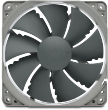
Noctua NF-P12 REDUX PWM 12V 1700RPM 120mm Quiet Case Fan

Noctua NF-S12B REDUX 12V 700RPM 120mm Quiet Case Fan

Noctua NF-F12 iPPC PWM 12V 3000RPM 120mm High Performance Fan

Noctua NF-A14 PWM chromax.black.swap 12V 1500RPM 140mm Fan
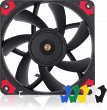
Noctua NF-A12x15 PWM chromax.black.swap 12V 1850RPM 120x15mm Fan

Noctua NF-A12x25 PWM 12V 2000RPM 120mm Ultimate Quality Quiet Fan

Noctua NF-A14 PWM 12V 1500RPM 140mm Premium Quality Fan

Noctua NF-A6x25 PWM 12V 3000RPM 60x25mm Low Noise Fan

Noctua NF-B9 REDUX 12V 1600RPM 92mm Quiet Case Fan

